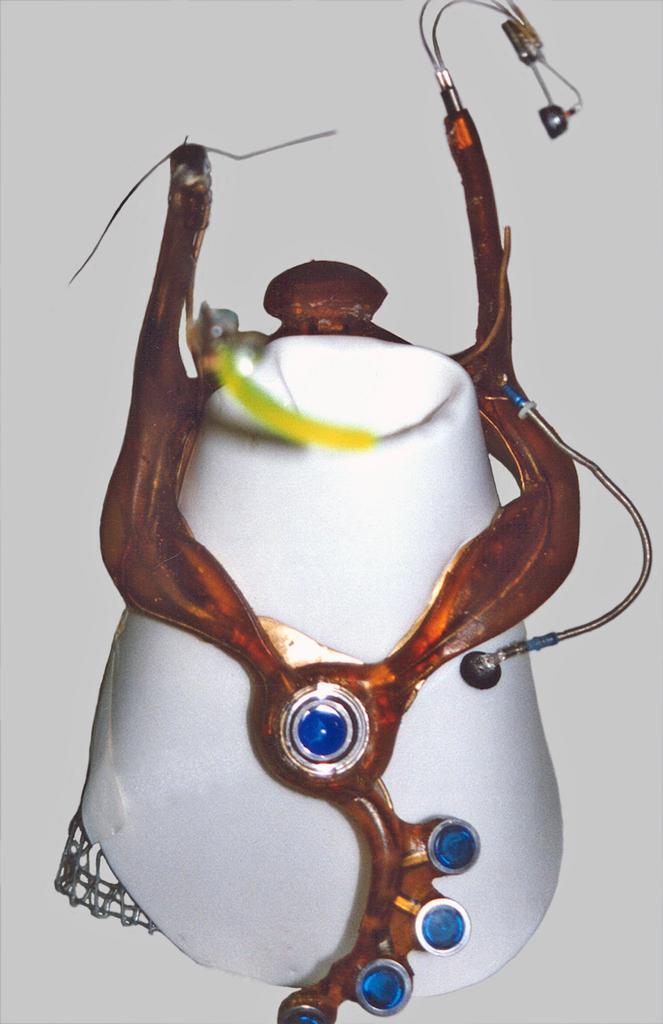I chanced upon this biomorphic beauty one day on collections.cooperhewitt.org.
Naturally, being part of the nerd department here at the Museum, I immediately showed it around. After a collective wave of “wooooah, dude,” we generally agreed that it was very awesome that our collection indeed contains the alien-space-slug-older-sister to the slick young whippersnapper in the wearable computing family—Google Glass.
This nerdtastically sci-fi-looking design is officially known as the Cyberdesk concept model for a wearable computer. The Cyberdesk was designed by Lisa Krohn. Those four blue dots dangling below the collarbone are a four-key keyboard. The fifth blue button over the throat (kinda creepy, eh?) is a small trackball. Hovering near the mouth is a small microphone. Over the wearer’s right eyeball is a glowing yellow tube meant to represent a virtual retinal scanner. Even more sci-fi than Google Glass (which projects visuals into a teeny glass prism that floats in front of the eye) the virtual retinal scanner actually projects a laser beam through the wearer’s pupil onto the retina, feeding visual information directly into the eye. Ahh!
Lisa Krohn’s website says this about the piece:
“It is counter to our survival to shut out our senses completely and trade in for an artificial world. Instead, why not overlap the real and the virtual? This personal information port is a pliable, high-tech garment which extends its user’s senses.”
The San Francisco Museum of Modern Art also has a Cyberdesk model in their collection, which looks like ours, but their version is white.
This isn’t Lisa Krohn’s only stroke of interaction design (IxD) clairvoyance represented in our collection. Krohn also anticipated today’s smart wristwatch phenomenon with the similarly playful and biomorphic prototype for a wrist computer she designed in 1988. Another interesting and prescient design by Krohn in our collection is a prototype for a desktop phone called The Phonebook, which Krohn designed during an internship at Smart Design while she was studying at the Cranbrook Academy of Art. Designed in collaboration with industrial designer Tucker Viemeister, The Phonebook aimed to simplify complicated interactions by creating a visual and functional analogy to the then-familiar fil-o-fax personal organizer. The design won attention and awards in its day for its innovative interaction design and forward-thinking good looks. Squeezing tons of interactivity into a phone that relies on skeuomorphic metaphors to familiar analog maneuvers sounds very familiar, no?
I wonder how Lisa Krohn’s work in the 1980’s would have looked if she had access to 2013’s tools: Arduino, augmented reality software, tiny displays and sensors, and the whole Sparkfun catalog. Lilypad Arduino is a prototyping tool that is synonymous with wearable computing today. I noticed that the twee/homesteader aesthetic of today’s wearble computing prototypes (presumably taking a cue from the maker movement) is very different from the Eva Hesse-meets-Terminator look of Krohn’s designs.
If today’s tools had been available in 1993, The Cyberdesk could have been a working prototype for a few hundred dollars! It’s a chicken and egg discussion, of course, because I don’t think today’s tools would have been developed without pioneering designers like Lisa Krohn, who illustrated that affordable prototyping tools were needed in the emerging discipline of interaction design.
Other objects in this post:
